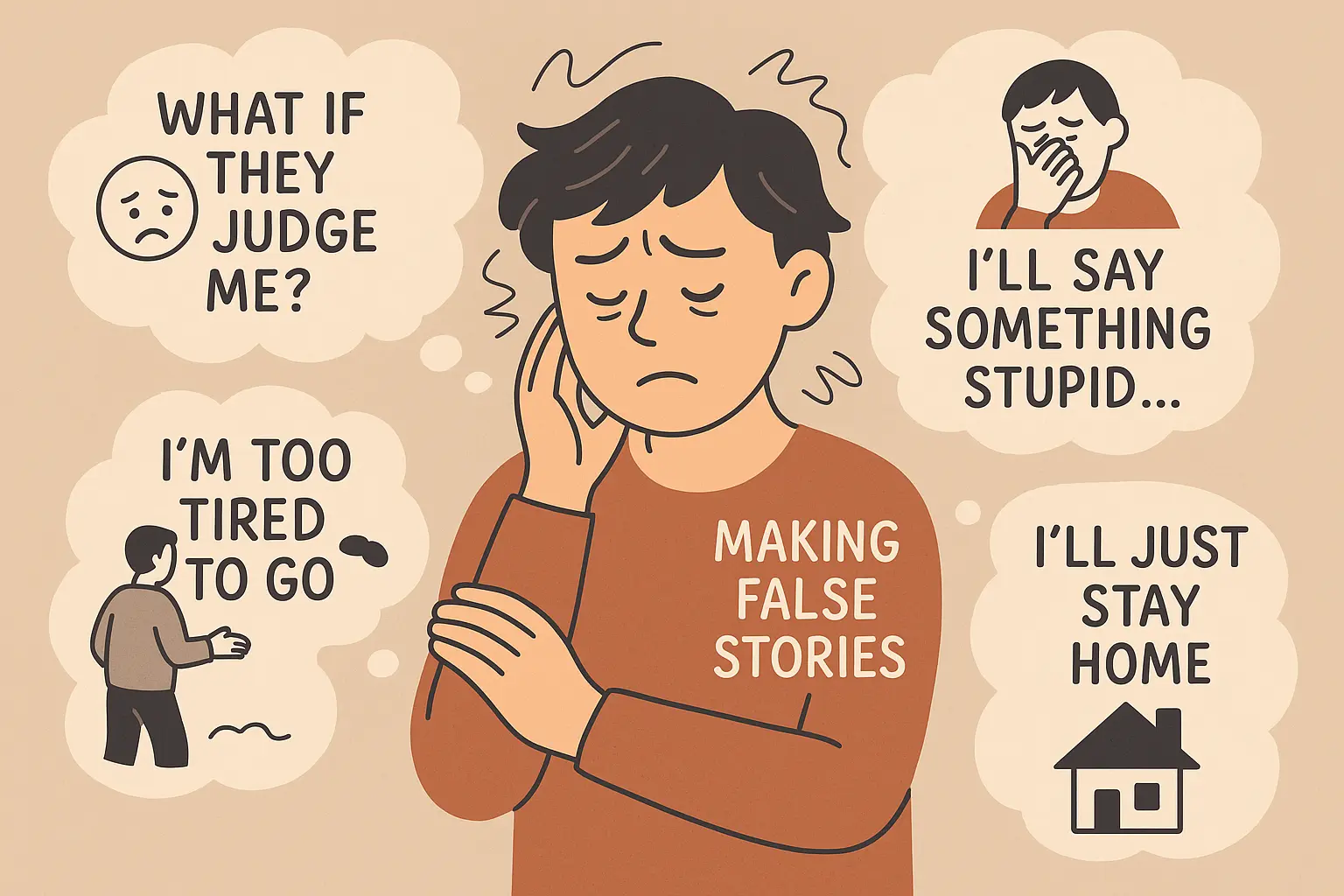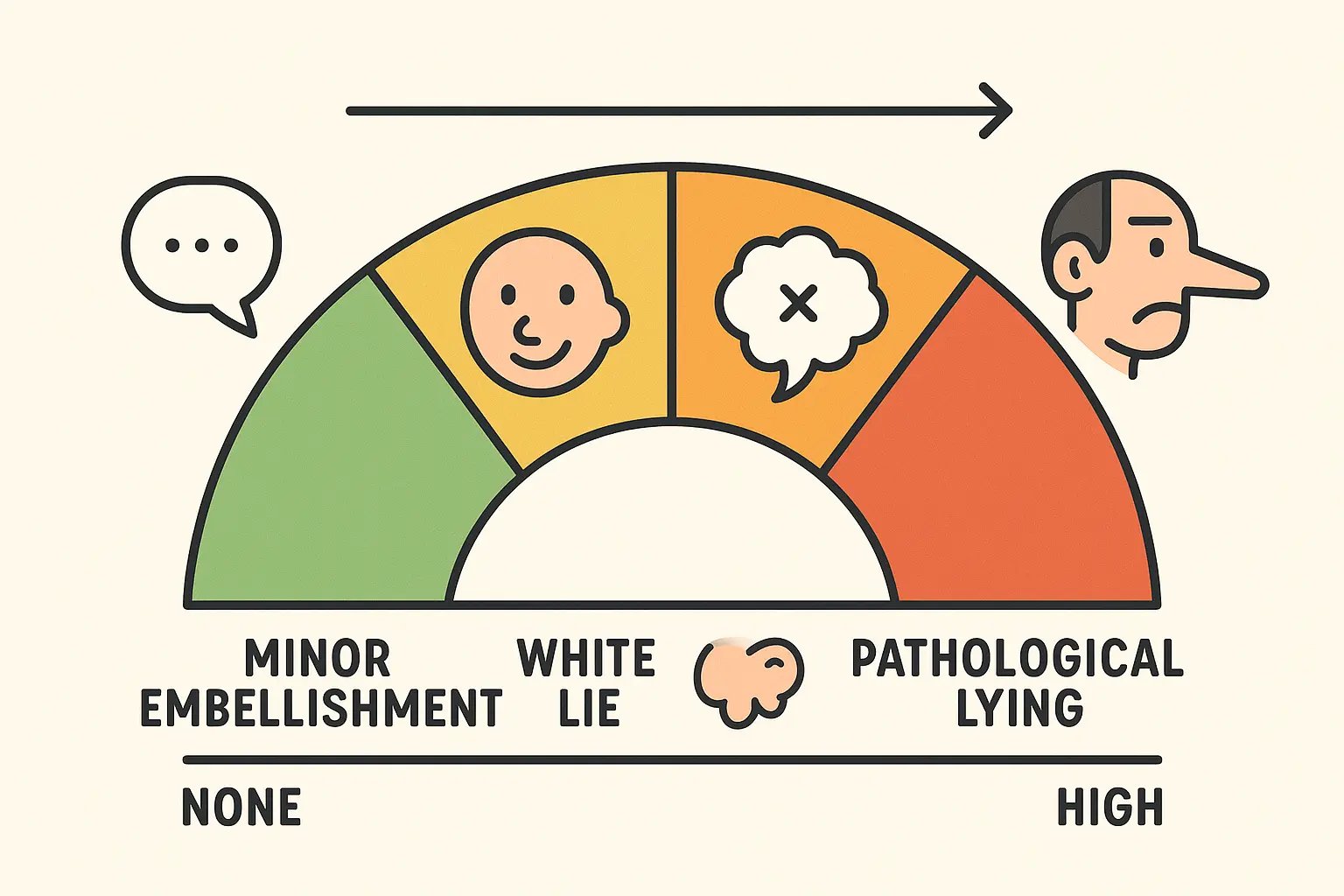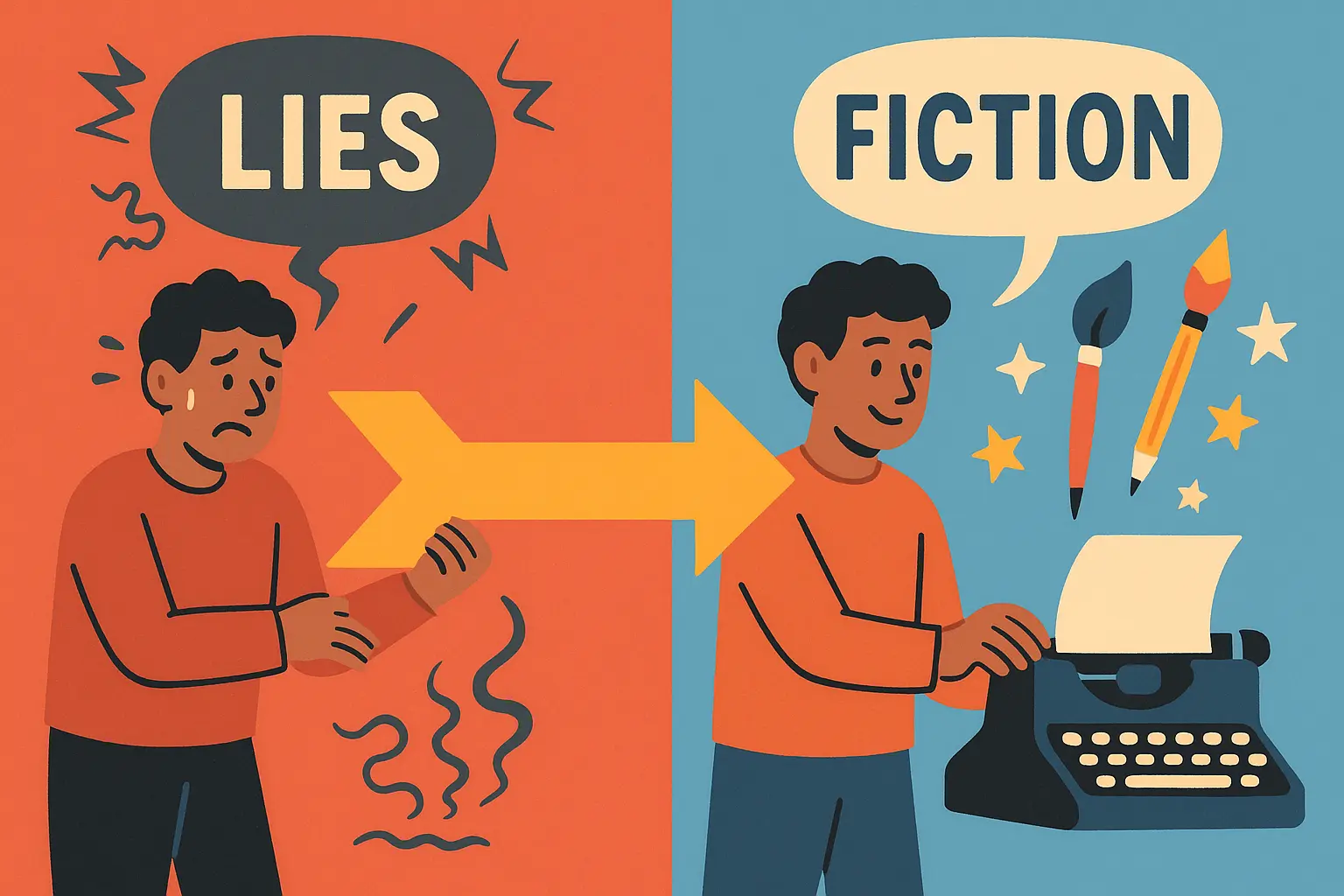I used to have a friend who could spin the most incredible stories. At first, I was fascinated – they always had the most interesting weekend adventures or the most dramatic work situations. It took me way too long to realize that almost none of it was true. That experience opened my eyes to just how complicated lying can be, and how much damage it does to the people we care about.
Maybe you recognize some of these patterns in someone you know. Or maybe – and this is hard to admit – you see yourself in some of these descriptions. Either way, you’re not alone in dealing with this.
Research from the Mental Health Hotline shows that compulsive lying involves “habitually lying without a clear benefit or reason,” and it affects way more relationships than most people realize. The thing is, not all lying is the same. Some people stretch the truth occasionally, while others can’t seem to tell the truth about anything – even stuff that doesn’t matter.
Table of Contents
- Understanding Why People Can’t Stop Lying
- The 25 Types of Constant Lying and Making Up Stories
- Figuring Out How Serious the Problem Is
- Turning Destructive Storytelling Into Something Positive
- Final Thoughts
TL;DR
- People lie constantly for different reasons – some can’t help it, others do it on purpose
- The 25 types fall into patterns: the ones who can’t control it, relationship-focused liars, people protecting themselves, those seeking personal gain, and people who might have deeper mental health stuff going on
- The really serious patterns like creating completely fictional life stories need professional help
- Some people only lie in certain situations or to specific people, but it still destroys trust
- A lot of lying comes from fear, shame, or feeling like you’re not good enough
- People who lie to get money, power, or special treatment are deliberately manipulating others
- Some lying patterns might mean someone has trouble telling what’s real and what isn’t
- Understanding what type of liar you’re dealing with helps you figure out how to respond
- The good news? People with great storytelling abilities can learn to channel that creativity into writing instead of deception
Understanding Why People Can’t Stop Lying
Before we dive into the specific types, here’s what I’ve learned: lying hurts relationships in different ways depending on how often it happens, why people do it, and whether they can even control it.
I remember discovering that my close friend had been making up stories about their weekend activities for months. It wasn’t until I realized the pattern that I understood we were dealing with something way more complex than just wanting to sound interesting.
Some people lie because they’re scared of disappointing others. Some do it because they feel boring compared to everyone else. Others learned early that telling the truth got them in trouble, so lying became their go-to move. And yes, sometimes people lie just because they can’t seem to help themselves.
The exhausting thing about loving someone who lies constantly is that you start questioning everything. Did they really have that doctor’s appointment? Are they actually working late? It’s emotionally draining to live in constant doubt.
When examining the psychology behind persistent fabrication, it’s helpful to understand how the brain processes storytelling, as many individuals who struggle with pathological lying possess strong narrative abilities that have become misdirected toward deceptive purposes.
Here’s the thing – some lying patterns are way more serious than others. If someone is creating completely fictional life stories and seems to believe them, that’s different from someone who just exaggerates their weekend plans. The first one probably needs professional help, while the second might just need some honest conversations.
| What to Look For | Not Too Serious | Pretty Concerning | Really Serious |
|---|---|---|---|
| How Often | Sometimes, in specific situations | Regular but only in certain areas | Every day, about everything |
| Do They Know They’re Lying | Yeah, they know | Sort of aware | Might not even realize |
| How It Affects Relationships | Some trust issues | Significant problems | Relationships falling apart |
| How Long It’s Been Going On | Started recently | Months to years | Years or decades |
| Why They Do It | Clear reason (avoid trouble, impress people) | Mixed reasons | No clear reason at all |
| Do They Need Professional Help | Maybe they can work on it themselves | Counseling would help | Definitely needs therapy |
Look, if someone in your life fits multiple patterns from this list, you’re probably dealing with something bigger than just “they stretch the truth sometimes.” Trust your gut. If you find yourself constantly fact-checking someone or feeling like you’re walking on eggshells, that’s your brain telling you something important.
The 25 Types of Constant Lying and Making Up Stories
1. The Big Storytellers (Classic Pathological Lying)
These are the people who create elaborate, ongoing stories about their lives that just aren’t true. We’re talking about claiming to have degrees they don’t have, relationships that never existed, or dramatic life events that never happened.
What makes this really scary is that they often start believing their own stories. I’ve met people who’ve created entire fake professional backgrounds, invented tragic family histories, or claimed to be dating celebrities. These aren’t little white lies – they’re complete alternate realities.
The lies don’t serve any obvious purpose, which is what makes them so hard to understand. Why make up something so elaborate when the truth would work just fine? That’s what makes this pattern so concerning – it suggests something deeper is going on that the person can’t control.
Unlike people who lie to get out of trouble, these folks maintain their stories consistently across all their relationships. They create these interconnected webs of lies that become impossible to keep straight, but they keep trying anyway.
2. The Automatic Liars (Compulsive Everyday Lying)
You know these people – they lie about the smallest things. Like saying they’re stuck in traffic when they just didn’t leave on time, or claiming they finished a project when they haven’t even started it. It sounds harmless, but after a while, you stop believing anything they say.
What’s frustrating is that they lie even when the truth would be totally fine. There’s no reason to make up these little stories, but they do it automatically, like it’s their default setting.
The really sad part is watching family members and friends start to doubt everything this person says. Even when they’re telling the truth, nobody believes them anymore because they’ve cried wolf too many times.
It’s like lying has become their first language, and they have to consciously choose to tell the truth instead of the other way around. That’s not normal, and it’s not healthy for anyone involved.
3. The Drama Magnets (Attention-Seeking Fabrication)
These people always have the most incredible stories designed to make you feel sorry for them or impressed by them. They’re constantly in crisis, constantly achieving amazing things, or constantly witnessing dramatic events that somehow never happen to anyone else.
The goal is pretty obvious – they want your attention and emotional reaction. They’ll invent medical emergencies, claim they saw accidents or crimes, make up family tragedies, or create stories about personal achievements that sound too good to be true.
What makes this particularly manipulative is that it exploits your natural desire to help and support people you care about. You end up giving them emotional support, practical help, or special treatment based on stuff that never actually happened.
Sarah’s Escalating Medical Dramas: Sarah began by claiming minor headaches that required her friends’ concern. Over months, these evolved into “severe migraines requiring emergency room visits,” then “possible brain tumor scares,” and eventually “rare neurological conditions” that required constant support from her social circle. Each fabricated medical crisis became more dramatic as her friends became less responsive to smaller claims, demonstrating how attention-seeking lies tend to escalate over time.
The stories usually get bigger and more dramatic over time because they need increasingly intense situations to get the same emotional response from people who are getting tired of the constant crises.
4. The Image Crafters (Identity Enhancement Lying)
These folks systematically create a more impressive version of themselves. They’ll claim to have degrees they don’t have, connections to famous people they’ve never met, or experiences they’ve only dreamed about.
The goal is to seem more interesting, successful, or important than they actually are. They might lie about their educational background, professional achievements, travel experiences, or social connections – basically anything that makes them sound cooler.
The tricky thing is that these lies are often consistent and maintained over long periods. It’s not just random exaggeration – it’s a carefully constructed alternate identity that they present to the world.
The danger is that they often start believing their own enhanced version of themselves. After telling people for months that they went to Harvard, they might actually start feeling like they did. It becomes harder and harder to separate their real experiences from their fabricated ones.
5. The Automatic Defenders (Defensive Habitual Lying)
We’ve all met someone who automatically lies the moment they think they might get in trouble. Spilled coffee on their shirt? “Traffic was crazy.” Forgot to call back? “My phone died.” They lie so fast about small stuff that you wonder what else they’re hiding.
This usually starts as a way to avoid getting in trouble, but it becomes such an automatic response that they do it even when the truth would be totally fine. They’ve learned that lying is their first line of defense against any potential criticism or conflict.
The sad part is that this often develops because somewhere along the way, telling the truth got them in serious trouble. So lying became their survival mechanism, but now they can’t turn it off even in safe relationships where honesty would be welcomed.
Over time, even people who love them start to feel like they can’t trust them with basic information. The defensive lying pushes away the very people who would be most understanding if they just told the truth.
6. The Fantasy Builders (Grandiose Fantasy Fabrication)
These people create stories that sound like they came straight out of a movie. They claim to have supernatural abilities, secret government connections, encounters with celebrities, or adventures that are clearly impossible.
What’s concerning is that they often seem to believe these elaborate fantasies themselves. They’re not just trying to impress you – they might actually think these things happened to them.

The stories get more and more elaborate over time, with new details and expanded plotlines. It’s like they’re living in an ongoing fantasy novel where they’re the main character, but they’re presenting it as their actual life.
This pattern often suggests there’s some deeper mental health stuff going on that affects how they see reality. It’s not just lying – it might be that they’re having trouble telling what’s real and what isn’t.
7. The Relationship Manipulators (Romantic Deception Patterns)
These people lie systematically within romantic relationships – about their past, their current activities, their feelings, or their intentions. They might fabricate their relationship history, lie about where they’ve been, fake emotional responses, or pretend to share interests they don’t actually have.
Romantic lying is particularly devastating because intimate relationships are supposed to be built on trust and vulnerability. When you discover that your partner has been lying about basic things, it makes you question everything about the relationship.
The lies often escalate over time as the person struggles to maintain their fake persona. They create different versions of themselves depending on what they think their partner wants to hear, which becomes exhausting and unsustainable.
What’s heartbreaking is that the very lies they tell to “protect” the relationship are exactly what ends up destroying it. They think they’re being loving by hiding things, but they’re actually preventing real intimacy from developing.
8. The Family Performers (Family Dynamics Lying)
These people put on completely different acts for different family members. They might lie to parents about grades or job performance, make up stories about their relationships with siblings, or create false narratives about their problems or successes.
Often, they’re trying to avoid disappointing family members or maintain a certain image within the family. They tell mom they’re doing great while telling dad they need money for an emergency, creating these complex webs of family deception.
Marcus’s Double Life at Home: Marcus told his parents he was excelling in college while actually failing multiple classes. He fabricated stories about dean’s list achievements, invented study group meetings to explain his absences, and even created fake transcripts. When his parents discovered the truth during graduation planning, the betrayal damaged not only their relationship with Marcus but also their trust in his siblings’ honesty, creating lasting family tension.
The really damaging part is that when the truth comes out, it doesn’t just affect the relationship with the person they lied to directly. It creates suspicion and doubt throughout the entire family system, making everyone question what else might not be true.
9. The Social Climbers (Social Circle Fabrication)
You know these people – they always have the most interesting weekend plans, the most expensive stuff, or the most exciting dating stories. They’re constantly trying to impress their friend group or maintain their social status through made-up experiences.
They might lie about what they did over the weekend, claim to own things they don’t have, make up dating experiences, or pretend to know people they’ve never met. The goal is to fit in or stand out within their social circle.
This often starts in high school but can continue well into adulthood, especially in competitive social environments. The lies get bigger and more elaborate as they try to keep up with their own fictional social image.
The exhausting part is that they often create different personas for different social groups, so they have to remember which lies they’ve told to which people. It becomes like a full-time job managing all the different versions of themselves.
10. The Workplace Actors (Professional Relationship Deception)
These are the people who lie about their work performance, qualifications, personal circumstances, or interactions with colleagues. They might claim projects are done when they’re not, lie about their experience or education, or make up personal situations to explain their work problems.

Professional lying can have serious consequences – job loss, damaged reputation, or even legal problems. But the competitive nature of many workplaces can make people feel like they have to lie to keep up or get ahead.
The scary part is when people lie about their qualifications or experience
The scary part is when people lie about their qualifications or experience, because then they end up in positions where they’re expected to do things they don’t actually know how to do. That can be dangerous for everyone involved.
We’ve all met the person at work who somehow always has a family emergency right before big deadlines, or who claims credit for work they didn’t do. These patterns become obvious pretty quickly to coworkers and supervisors.
11. The Sympathy Seekers (Caregiver Manipulation Lying)
These people make up stories specifically to get others to take care of them. They’ll exaggerate health problems, create fake financial emergencies, or invent personal crises to get attention, help, or resources from family, friends, or even professional caregivers.
What makes this particularly awful is that it takes advantage of people’s natural compassion and desire to help those in need. Caregivers might provide extensive time, energy, and resources based on completely fabricated problems.
The lies often escalate over time as the person becomes accustomed to the attention and support they’re receiving. They need increasingly dramatic crises to maintain the same level of care and concern from others.
This pattern is emotionally abusive because it exploits the love and kindness of others. When people discover they’ve been manipulated into providing care based on lies, it often leaves them feeling used and questioning their ability to trust their own compassion.
12. The “Oh Crap” Liars (Consequence Avoidance Fabrication)
You know these people – they automatically lie the moment they think they might get in trouble. They create elaborate excuses for poor performance, make up alibis for questionable behavior, or invent circumstances to explain away their failures or mistakes.
While this might provide temporary relief from immediate consequences, it usually creates much bigger problems down the road. The lies get discovered, leading to worse consequences than if they’d just been honest in the first place.
Plus, the pattern prevents them from actually learning from their mistakes or developing better coping strategies. They’re so focused on avoiding consequences that they never address the underlying problems causing those consequences.
The automatic nature of this lying is what makes it so destructive. They lie so quickly and reflexively that they often don’t even consider whether the truth might actually be better in the long run.
13. The Secret Keepers (Shame-Based Concealment Lying)
These people lie constantly to hide things they’re deeply ashamed of – their financial situation, living circumstances, family background, or personal struggles. The lies serve as a protective barrier against what they imagine would be judgment or rejection.
They might make up stories about their job, living situation, family relationships, or social life to avoid revealing circumstances they find embarrassing. The shame is so intense that lying feels safer than risking people’s reactions to the truth.
This pattern is heartbreaking because the energy required to maintain all these cover-up lies is emotionally exhausting. They’re spending so much mental energy on maintaining their fictional image that they can’t focus on actually improving their real circumstances.
Often, the things they’re ashamed of aren’t even that big a deal to other people, but the shame feels so overwhelming that they can’t imagine anyone accepting them if the truth came out. The lies become a prison that keeps them isolated from genuine connection.
14. The “I’m Fine” People (Inadequacy Compensation Lying)
These folks constantly make up stories to hide the fact that they feel like failures. They’ll lie about job performance, social connections, personal achievements, or basically anything that makes them seem more successful than they actually are.
The lies are trying to bridge the gap between how they see themselves (not good enough) and how they want others to see them (successful and capable). They might claim promotions they didn’t get, friendships that don’t exist, or accomplishments that never happened.
What’s sad is that while the lies might make them feel better temporarily, they prevent them from developing real skills or genuine self-acceptance. They get so caught up in maintaining their fake successful image that they don’t work on actually becoming successful.
The inadequacy they’re trying to hide often becomes a self-fulfilling prophecy because they’re spending all their energy on lies instead of personal growth.
15. The Survivors (Trauma-Related Fabrication)
Sometimes people who’ve been through terrible experiences develop lying patterns as a way to cope. They might create alternative versions of events, make up support systems that didn’t exist, or invent circumstances that feel safer than what really happened.
This might include creating false memories of getting help during difficult times, making up positive relationships to replace traumatic ones, or lying about their current safety and stability. The lies serve as psychological protection from overwhelming pain.
This pattern is different from others because the lying often started as a genuine survival mechanism. When reality was too painful or dangerous, creating alternative stories helped them get through it.
The problem is that what helped them survive trauma can become problematic when it interferes with healing and building healthy relationships in the present.
16. The Worriers (Anxiety-Driven Deception)
These people lie compulsively because they’re terrified of social judgment, rejection, or conflict. They’ll make up stories to avoid situations they think might threaten their social standing or emotional well-being.
They might lie about social plans to avoid potential rejection, make up reasons for declining invitations, create false explanations for anxiety-related behaviors, or invent circumstances to justify avoiding social situations altogether.

The lying provides temporary relief from their anxiety, but it creates additional stress because now they have to remember and maintain all their fabrications while also worrying about being discovered.
Often, there’s underlying anxiety or social anxiety that would benefit from professional treatment. The lying is just a symptom of the deeper anxiety problem.
17. The Control Freaks (Control Maintenance Lying)
These people lie systematically to maintain control over how others see them and their circumstances. They’re terrified of being vulnerable or appearing weak, so they create false narratives to maintain their image of independence and capability.
They might lie about personal problems to avoid getting help, make up stories about their abilities to avoid appearing incompetent, or create false narratives about their relationships to avoid concern from others.
While the lies might help them feel in control temporarily, they actually prevent them from getting support they might genuinely need and from developing real independence and self-sufficiency.
The fear of vulnerability that drives this pattern often stems from past experiences where being vulnerable led to being hurt or taken advantage of.
18. The Scammers (Material Gain Fabrication)
These people lie deliberately to get money, possessions, services, or other material benefits from others. They create fake emergencies, fabricate business opportunities, or invent circumstances that justify receiving resources from others.
This might include lying about financial emergencies to borrow money, making up medical needs to get expensive treatments paid for, creating false investment opportunities, or inventing situations that justify receiving gifts or support.
This pattern is particularly concerning because it involves deliberately exploiting others’ generosity and trust. Unlike other lying patterns that might stem from psychological issues, this is calculated manipulation designed to benefit the liar at others’ expense.
The lies often become more sophisticated over time as the person gets better at manipulation or needs larger amounts of resources to maintain their lifestyle.
19. The Status Seekers (Social Status Enhancement Lying)
These people create elaborate stories to make themselves seem more important, successful, or impressive within their social circles. They want admiration and respect, so they fabricate achievements, connections, or experiences that would make others look up to them.
They might lie about educational achievements, make up professional success stories, claim to have met celebrities, or invent expensive possessions or experiences. The goal is creating an impressive social image that attracts admiration.
This often comes from deep insecurity about their actual social standing and fear of being seen as ordinary or unimportant. The lies might work temporarily, but they create pressure to maintain increasingly elaborate fabrications.
The mental energy required to keep track of which impressive stories they’ve told to which people becomes exhausting, and the fear of being exposed creates constant anxiety.
20. The Power Players (Power and Influence Fabrication)
These people lie to gain power, influence, or control over others. They create false expertise, authority, connections, or capabilities that position them as someone others should defer to or follow.
This might include lying about professional qualifications to gain authority, making up connections to powerful people, creating false expertise in important areas, or inventing circumstances that make others dependent on them.
This pattern can be dangerous because it can lead to situations where the person makes important decisions or gives advice based on fabricated expertise. When their lack of real qualifications is discovered, it can put others at risk.
The lies often escalate gradually as the person gets comfortable with the power and influence their fabrications provide, potentially leading them into positions where their deception becomes genuinely dangerous.
21. The Crisis Creators (Sympathy and Support Manipulation)
These people constantly create false narratives of hardship, illness, or crisis specifically designed to get emotional support, practical help, or special treatment from others. They’re exploiting people’s natural desire to help those in distress.
They might make up serious illnesses, create fake family tragedies, lie about financial disasters, or invent personal crises that require immediate attention and support. The fabricated emergencies are designed to trigger caregiving responses from others.

What makes this particularly manipulative is that it takes advantage of people’s compassion and empathy. The fake crises often become more dramatic over time as the person needs increasingly intense situations to get the same level of support and attention.
This pattern can be emotionally abusive because it exploits the love and concern of others while preventing genuine intimacy and trust from developing.
22. The Reality Blurrers (Reality Testing Impairment)
These people create elaborate stories that they might actually believe themselves. They have trouble distinguishing between their fantasies and reality, which sometimes indicates deeper mental health issues affecting their perception and judgment.
This might include creating alternative life histories, making up ongoing relationships with people who don’t exist or are deceased, inventing conspiracy theories involving themselves, or creating false memories of events that never happened.
What’s different about this pattern is that the person may genuinely believe aspects of their fabricated stories. They’re not necessarily trying to deceive others – they might be confused about what’s real themselves.
This often requires professional psychological evaluation and treatment because it suggests serious underlying mental health conditions that affect their ability to process reality accurately.
23. The Impulse Storytellers (Impulsive Storytelling Compulsion)
These people lie automatically and involuntarily, often surprising themselves with the stories that come out of their mouths. The lies seem to happen without conscious planning or clear motivation, suggesting impulse control issues or neurological factors.
They might spontaneously create false explanations for simple questions, automatically embellish stories without meaning to, impulsively agree to false statements about themselves, or involuntarily add fictional details to routine experiences.
The automatic nature of this lying makes it particularly difficult for the person to control, even when they recognize it as problematic. They often feel frustrated with themselves because the lies seem to come out before they can stop them.
This pattern suggests underlying neurological or psychological factors that affect impulse control and verbal behavior, making traditional approaches to addressing lying less effective.
24. The Excuse Factory (Chronic Excuse Manufacturing)
These people consistently create elaborate explanations for their failures, problems, or bad behavior. While everyone makes excuses sometimes, these folks systematically fabricate circumstances to avoid taking responsibility for anything that goes wrong.
They’ll create false explanations for poor performance, make up circumstances that prevented their success, lie about factors beyond their control affecting their outcomes, or invent complex reasons for not meeting their obligations.
David’s Elaborate Work Excuses: When David missed important deadlines, he created increasingly complex explanations: first it was “computer problems,” then “family emergencies,” followed by “medical appointments,” and eventually “car accidents” and “power outages.” His supervisor noticed the pattern when David claimed his grandmother died three separate times in six months, each time to excuse missed work. The elaborate nature of his excuse manufacturing ultimately led to his termination.
The excuses become more and more implausible over time, often making it obvious that they’re fabrications. This prevents personal growth because the person never takes responsibility for their problems or learns from their mistakes.
25. The Automatic Embellishers (Habitual Embellishment Compulsion)
These folks can’t tell a simple story without making it more dramatic, interesting, or significant than it actually was. They automatically enhance, exaggerate, or completely fabricate details when talking about real events.
They might consistently exaggerate the importance of routine events, add fictional details to true stories, inflate their role in group activities, or create dramatic elements that didn’t exist in the actual experience.
This can be particularly frustrating for friends and family who were there and know what really happened. While it might seem less harmful than other lying patterns, it still damages trust and credibility over time.
The compulsive nature of embellishment often mirrors the creative process behind effective storytelling themes, but applied inappropriately to real-life situations rather than fictional narratives.
Figuring Out How Serious the Problem Is
Understanding how serious different lying patterns are helps you figure out how to respond and whether professional help is needed. The really concerning patterns like creating completely fictional life stories, having trouble distinguishing reality from fantasy, and deliberately manipulating people for personal gain usually require professional intervention.
These severe patterns often involve elaborate, persistent lies that the person struggles to control and may indicate underlying psychological conditions. The lying completely destroys trust in relationships and makes it impossible for the person to function normally in work, family, or social situations.
| Type of Lying | Examples | Why They Do It | What Kind of Help They Need |
|---|---|---|---|
| Really Serious | Fake life stories, believing fantasies, can’t tell what’s real | Can’t control it/mental health issues | Professional therapy required |
| Pretty Serious | Lying for money/power, manipulating caregivers | Deliberately exploiting others | Professional counseling recommended |
| Concerning | Fake achievements, romantic deception, sympathy seeking | Image/attention issues | Counseling would help |
| Problematic | Social lies, work lies, family lies | Situational/defensive | Self-help with support |
| Annoying but Manageable | Embellishing stories, making excuses, everyday lies | Habit/avoidance | Self-awareness and behavior change |
Moderate patterns like lying for attention, creating fake achievements, or manipulating romantic partners cause significant relationship problems but might be more responsive to intervention than the severe cases.

The less severe patterns like defensive lying, social exaggeration, and chronic excuse-making are still problematic but might be more responsive to self-awareness and behavioral changes.
Understanding why people lie also helps determine the best approach:
| Why They Lie | What Patterns Look Like | Main Issues | How to Help |
|---|---|---|---|
| Can’t Control It | Automatic lying, believing fantasies, impulsive stories | Little conscious control, might believe their own lies | Professional mental health treatment |
| Protecting Themselves | Defensive lies, shame-based hiding, anxiety-driven stories, trauma responses | Fear-based, defensive reactions | Therapy addressing underlying issues |
| Getting Something | Lying for money, status, power | Goal-oriented manipulation | Behavioral intervention, accountability |
| Image Problems | Fake achievements, compensating for inadequacy, attention-seeking | Self-esteem and image concerns | Self-worth therapy, social skills training |
| Relationship-Specific | Romantic lies, family lies, work lies, social lies | Context-dependent patterns | Relationship counseling, communication skills |
Turning Destructive Storytelling Into Something Positive
Here’s something cool I’ve discovered – a lot of people who struggle with lying are actually amazing storytellers. They have incredible imaginations and can create vivid, engaging narratives. The problem isn’t the creativity; it’s that they’re using it in relationships instead of channeling it into writing, theater, or other creative outlets where making stuff up is actually the point.
For people dealing with compulsive storytelling patterns, getting involved in legitimate creative writing can provide an outlet for their narrative impulses without the relationship damage caused by deceptive behavior. The key is channeling creativity toward clearly identified fiction rather than presenting made-up stories as truth.

Someone who lies compulsively often possesses exceptional narrative abilities that could be channeled into short story writing, where their imagination becomes a creative asset rather than a destructive force in relationships.
Whether someone is working to overcome lying patterns or just exploring their creative potential honestly, having access to structured creative tools provides satisfaction for their storytelling impulses without the complications that come from presenting fiction as fact. The goal is transforming destructive patterns into enriching creative expression that builds rather than damages relationships and personal integrity.
Understanding effective story examples can help people redirect their narrative talents toward constructive creative outlets rather than deceptive relationship patterns.

I’ve seen people who struggled with compulsive lying become successful writers, screenwriters, or storytellers once they learned to channel their abilities appropriately. The same imagination that created problems in their personal relationships became a source of joy, connection, and even income when used honestly.
Final Thoughts
Writing this piece made me think about all the relationships I’ve seen damaged by dishonesty – including some of my own. It’s heartbreaking because underneath all the lies, there’s usually someone who desperately wants connection but doesn’t know how to be vulnerable enough to get it honestly.
Recognizing these 25 types of constant lying represents the first step toward addressing these complex behaviors. Each pattern serves different purposes and requires different approaches, whether you’re dealing with someone who lies constantly or recognizing these tendencies in yourself.
Before we judge others too harshly, it’s worth asking ourselves: Do I ever embellish stories to make them more interesting? Do I sometimes lie to avoid uncomfortable conversations? Most of us do this occasionally – the difference is frequency and impact.
Remember that behind every pattern of lying lies a human being struggling with underlying issues – whether shame, trauma, anxiety, inadequacy, or other psychological factors. Approaching these behaviors with understanding rather than judgment creates better opportunities for positive change and healing.
If you see yourself in these patterns, please consider reaching out to a counselor or therapist. If you’re dealing with someone else’s constant lying, remember that you can’t change them, but you can change how you respond. Either way, you deserve relationships built on truth.
For those whose creative storytelling impulses have become destructive, there’s genuine hope in redirecting these abilities toward healthy creative expression. The same narrative gifts that create problems in relationships can become sources of joy, connection, and personal fulfillment when channeled appropriately.
Bottom line: If lying is destroying your relationships or causing you constant stress, it’s time to get help. If you love someone whose lying is hurting you, you can’t fix them, but you can decide what you’re willing to accept. Trust your instincts, protect your own well-being, and remember that healthy relationships are built on honesty, even when the truth is uncomfortable.



Add comment